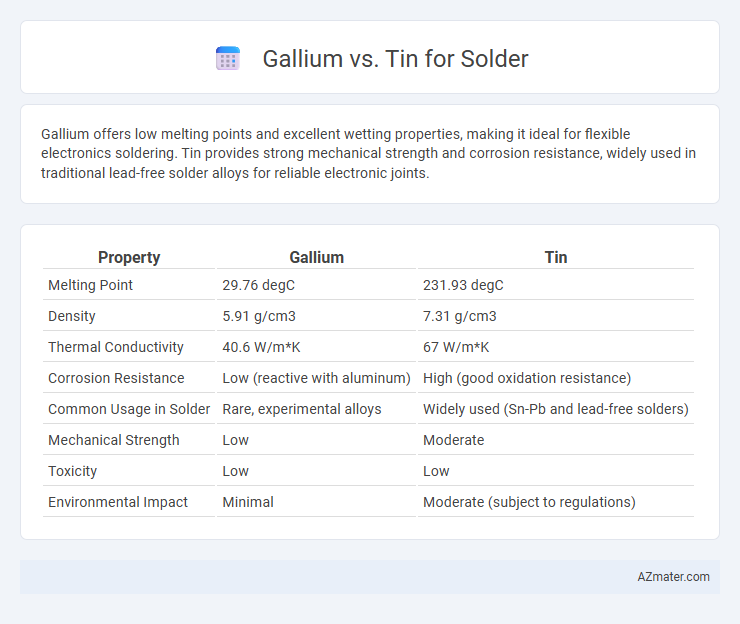Gallium offers low melting points and excellent wetting properties, making it ideal for flexible electronics soldering. Tin provides strong mechanical strength and corrosion resistance, widely used in traditional lead-free solder alloys for reliable electronic joints.
Table of Comparison
| Property | Gallium | Tin |
|---|---|---|
| Melting Point | 29.76 degC | 231.93 degC |
| Density | 5.91 g/cm3 | 7.31 g/cm3 |
| Thermal Conductivity | 40.6 W/m*K | 67 W/m*K |
| Corrosion Resistance | Low (reactive with aluminum) | High (good oxidation resistance) |
| Common Usage in Solder | Rare, experimental alloys | Widely used (Sn-Pb and lead-free solders) |
| Mechanical Strength | Low | Moderate |
| Toxicity | Low | Low |
| Environmental Impact | Minimal | Moderate (subject to regulations) |
Introduction to Soldering: Gallium vs Tin
Gallium and tin are both metals used in soldering, each with distinct melting points and bonding properties. Tin, traditionally favored in electronics soldering, melts at 231.9degC and offers strong mechanical and electrical connections. Gallium melts at a lower temperature of 29.8degC, enabling soldering on heat-sensitive components but can cause aluminum corrosion, limiting its applications.
Chemical Properties of Gallium and Tin
Gallium exhibits a low melting point of 29.76degC and forms a stable oxide layer, enhancing its wetting properties in solder applications, while tin melts at 231.93degC and is widely favored for its excellent solderability and corrosion resistance. Gallium's atomic structure allows it to expand upon solidification, unlike tin which contracts, influencing joint integrity and thermal stability. Both metals interact differently with other solder constituents, with gallium showing limited intermetallic compound formation compared to tin, impacting mechanical strength and electrical conductivity in alloy systems.
Melting Points: Suitability for Soldering
Gallium has a melting point of approximately 29.8degC, making it a low-temperature metal ideal for soldering applications requiring gentle heat to avoid damaging sensitive components. Tin melts at around 231.9degC, providing a higher melting point that is suitable for robust, high-temperature solder joints in electronics. The significant difference in melting points between gallium and tin influences their suitability, with gallium best for delicate, low-heat soldering and tin preferred for durable, heat-resistant connections.
Electrical Conductivity Comparison
Gallium exhibits electrical conductivity of approximately 7.8 x 10^6 S/m, which is significantly lower than tin's conductivity of about 9.17 x 10^6 S/m. Tin, commonly used in solder alloys, offers superior electrical conductivity, enhancing signal integrity and reducing resistive losses in electronic connections. The lower conductivity of gallium-based solders may impact performance in high-frequency or high-current applications where minimal resistance is critical.
Oxidation Resistance and Durability
Gallium exhibits superior oxidation resistance compared to tin, forming a stable oxide layer that protects the underlying metal during soldering processes. Tin, while commonly used in solder alloys, tends to oxidize more readily, leading to potential joint weaknesses and reduced durability. Due to gallium's enhanced resistance to oxidation, solder joints incorporating gallium maintain stronger mechanical integrity and longer lifespan under environmental stress.
Impact on Electronics Performance
Gallium-based solders offer superior thermal conductivity and lower melting points compared to tin, enhancing heat dissipation in sensitive electronic components. Tin, widely used in traditional solders, provides excellent mechanical strength and corrosion resistance, maintaining long-term reliability in circuits. The choice between gallium and tin significantly affects electrical conductivity, thermal management, and the overall durability of electronic assemblies.
Safety and Environmental Considerations
Gallium is less toxic and poses lower environmental hazards compared to tin, making it a safer choice in solder applications where exposure risks are a concern. Tin, while generally considered safe, can release harmful fumes such as stannic oxide during soldering, which requires proper ventilation to mitigate health impacts. Environmental disposal of gallium is less problematic due to its lower bioaccumulation potential, whereas tin residues can contribute to soil and water contamination if not managed properly.
Cost-Effectiveness and Availability
Gallium solder offers excellent wetting properties and low melting points but is significantly more expensive and less readily available than tin-based solder, impacting cost-effectiveness for large-scale applications. Tin solder remains the industry standard due to its affordability, widespread availability, and reliable mechanical strength, making it the preferred choice for most consumer electronics and industrial use. The scarcity and higher cost of gallium limit its practicality despite its advantageous physical properties.
Applications in Modern Electronics
Gallium and tin serve distinct roles in solder applications for modern electronics, with tin being the principal component in traditional and lead-free solder alloys due to its excellent wetting properties and mechanical strength. Gallium's low melting point and ability to alloy with metals like aluminum make it suitable for specialized applications such as flexible electronics and low-temperature bonding processes. The choice between gallium and tin-based solders hinges on factors including thermal stability, electrical conductivity, and compatibility with electronic components in devices like smartphones, wearable technology, and high-reliability circuits.
Future Trends in Solder Material Choices
Gallium is emerging as a promising alternative to tin in solder materials due to its low toxicity and superior wetting properties, enabling improved joint reliability in electronics manufacturing. Research trends indicate increased adoption of gallium-based solders in flexible and wearable devices, driven by their low melting points and compatibility with temperature-sensitive components. Market forecasts predict a shift towards eco-friendly and lead-free solder alloys, with gallium-tin composites gaining traction to optimize thermal performance and mechanical strength in next-generation electronic assemblies.

Infographic: Gallium vs Tin for Solder
 azmater.com
azmater.com